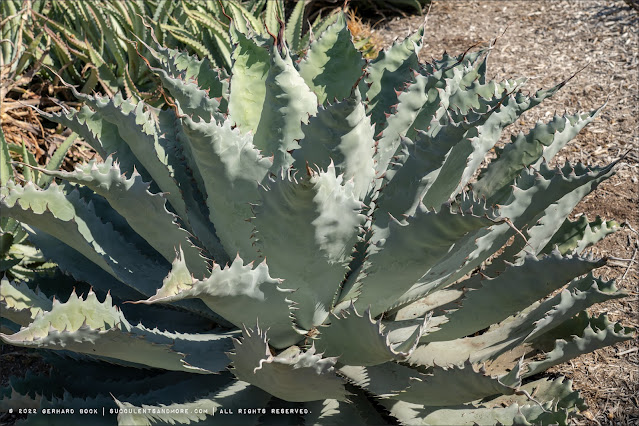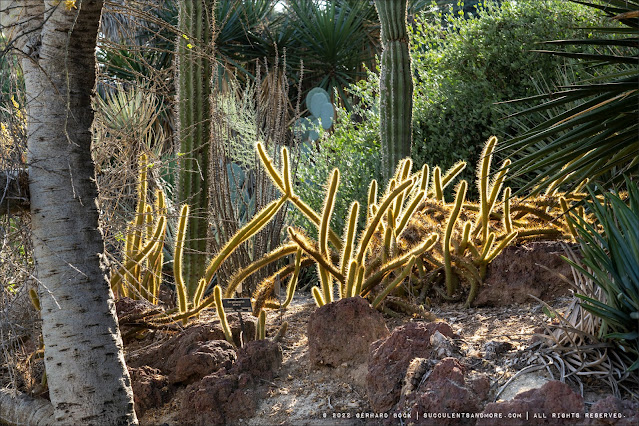This post continues my late-afternoon ramble through the Desert Garden at the Huntington in San Marino. Click here to read part 1.
Here are some fun facts about the Desert Garden:
Fun fact
William Hertrich (1878-1966), the Huntington’s first superintendent of buildings and grounds, worked at the Huntington from 1904 to 1948 when he retired. In the Desert Garden’s early days, he went on a series of large-scale collecting trips. In 1908, he hauled three railway wagons of cacti from Arizona, including a wagon of saguaros. This was followed in 1912 by two wagons of cacti and other succulents from Mexico. The Huntington estate had its own spur line, making rail transport easy. [*]
 |
| Borzicactus fossulatus and Agave parryi var. truncata |
 |
| Diamond cholla (Cylindropuntia ramosissima) |
 |
| Agave potatorum with emerging flower stalk |
 |
| The showiest Agave potatorum I’ve ever seen |
 |
| Agave marmorata, still a juvenile. This will be a BIG plant someday! |
Fun fact
Henry Huntington didn’t like cacti. In his younger years, when supervising work for the Southern Pacific Railroad, which was owned by his uncle, he backed into a prickly pear and never forgot the unpleasant experience. Later, however, he took great pride in having one of the most significant succulent collections in the country and loved to show it off to visitors. Apparently he was very competitive and wanted the best of everything. [*]
 |
| Old man of the Andes (Oreocereus celsianus) |
 |
| When you plant a dyckia in the ground, be aware that it has the potential to become massive over time |
 |
| Aloe africana × cameronii, an interesting hybrid I’d never seen before |
 |
| Agave franzosinii |
 |
| The small backlit tree is called palo Adán (Fouquieria diguetii) |
 |
| Bromelia ballansae with bright red flowers |
 |
| Agave titanota |
 |
| Yucca filifera |
Fun fact
The oldest cactus in the garden is a Cereus xanthocarpus, planted as a mature specimen in 1905. Weighing an estimated 20 tons, it’s also the gardens most massive plant. [*]
 |
| Aloes blooming under majestic dragon trees (Dracaena draco) |
 |
| Crassula capitella and Agave attenuata ‘Boutin Blue’ |
 |
| Cleistocactus and other columnar cacti |
 |
| Agave ‘Blue Flame’ and Agave impressa |
 |
| Parodia magnifica and Agave ‘Blue Flame’ |
Fun fact
Of the many hundreds of golden barrel cacti (Echinocactus grusonii) found throughout the Desert Garden, some are 85 years or older and weigh hundreds of pounds. [*]
 |
| Agave oteroi and Echinocactus grusonii |
 |
| Hechtia rosea |
 |
| Hechtia gayorum |
 |
The rosettes of Hechtia gayorum are very small but so colorful at this time of year
|
 |
| Wider shot in the Upper Garden (Old World) |
 |
| A cheerful little aloe without a tag |
 |
| Aloe schelpei |
 |
| Aloe schelpei |
 |
| Another Aloe ‘Sophie’ (Aloe sinkatana × harlana) |
Fun fact
Roberto Burle Marx, the famed Brazilian landscape architect, once called the Desert Garden “the most extraordinary garden in the world.” [*]
© Gerhard Bock, 2022. All rights reserved. To receive all new posts by email, please subscribe here.











































I enjoyed the excellent photos and 'fun facts'. I find the Dracaena draco tree mind blowing!
ReplyDeletechavli
Agreed!! If I lived in the right climate and had room, I'd plant a small grove of Dracaena draco!
DeleteI think the Huntington should commission you to produce a book on the Desert Garden. I love the shot of the Boojum tree, which is odd and wonderful at the same time. Your closeups of Agave potatorum's "fangs" are impressive too. I'm surprised to see so many Aloes already in bloom. Your warning about Dyckia's inclination to spread was timely as I was considering freeing a couple of mine from their pots just yesterday.
ReplyDeleteI think the aloes are early this year. Must have been the crazy rains in September followed by a long period of warm weather.
DeleteAs for the dyckias, you don't have anything to fear by putting them in ground. It's not like they grow into an impenetrable thicket over night.
Great photos, congratulations! I think one should only visit 'gardens' in the fall light. Amazing colours, contrasts, shades. Top 3 favourite are, 'dyckia in the ground', 'aloes blooming under majestic dragon tree' and 'wider shot in the Upper Garden'.
ReplyDeleteIt's amazing how the light is good pretty much all day in the fall :-)
DeleteI would agree with Roberto Marx's comment. It is spectacular. Looking at the ground cover of Devil's cactus and Dyckia I sympathize with the gardeners who might have to do any work in those patches. Some really gorgeous specimens in the garden. I love the little spiral spine tip on the A. potatorum. Based on Huntington's early experience it's a wonder the cactus/succulent garden ever came about.
ReplyDeleteI guess having a cactus garden was a must back then so Huntington really didn't have a choice if he wanted to keep up with the Joneses, ha ha.
DeleteAnother fun fact is the biggest oldest golden barrel cacti at the Huntington were grown from seeds in the garden.
ReplyDeleteYeah, another fun fact! Love it!
Delete